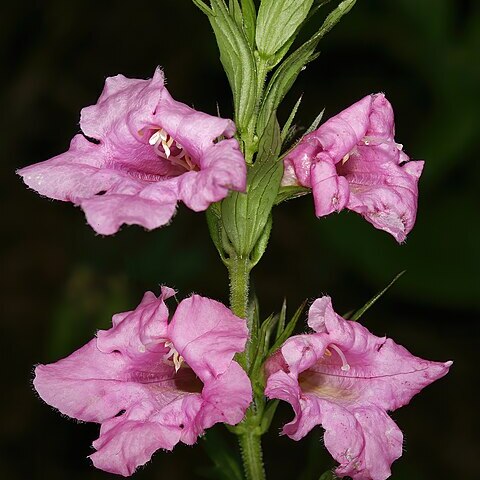Perennial herb or suffrutex, parasite, 0.08-0.65 m high; stem erect, herbaceous when young, branched at base, pilose. Leaves 10-22(-30) x 4-17 mm, subsessile, opposite or alternate, lanceolate, margins incised-pinnatifid with acute teeth; nerves prominent beneath. Inflorescence a raceme; flowers pink, in axils of upper leaves, shortly pedicellate, bibracteolate. Calyx 7-10 mm long, campanulate, hispid; lobes triangular-lanceolate. Corolla funnel-shaped; tube pubescent; lobes broadly rounded, spreading. Stamens: filaments filiform, pilose; anthers glabrous. Ovary somewhat gibbous; style filiform, persist in young fruits. Flowering time Aug.-Mar.
Leaves opposite or nearly so or alternate, 10–22(30) x 4–17 mm., ovate elliptic or more usually lanceolate, acute, subcuneate to subsessile at base, margins incised-pinnatifid with acute teeth or rarely subentire, scabrid-hispid, 3–5-nerved with nervation prominent beneath.
Erect, ascending or rarely procumbent perennial suffrutex, 7–30 cm. tall, from a woody rootstock, usually branched at or near the base; stems obtusely quadrangular above, indumentum of large multicellular pilose hairs, leafy, slightly herbaceous (at least when young).
Semiprostrate to erect herb, up to 400 mm tall. Leaves 3-or 5-nerved at base, coarsely dentate or incised-pin-natifid, rigid, scabrous. Filaments covered with patent hairs only at base. Flowers pink.
Calyx 7–10 mm. long, campanulate, deeply 5-lobed, 10-nerved, scabrid hispid or pubescent especially on nerves; lobes 4–6 mm. long, triangular lanceolate, acute.
Corolla funnel-shaped; tube 10–15 mm. long, sparsely pubescent without; limb 13–16(22) mm. in diam.; lobes 4–9 mm. long, broadly rounded, spreading.
Capsule 7 mm. long, 6–7 mm. wide, strongly longitudinally compressed, appearing broadly unilaterally winged, included in persistent calyx.
Hemiparasitic perennial to 60 cm. Leaves shortly hairy, coarsely toothed. Flowers in lax racemes, pedicels short, pink to mauve.
Flowers purple mauve or pink, in axils of upper leaves, subsessile to shortly pedicellate and bibracteolate.
Bracteoles 5–8.5 x 0.6–1 mm., sublanceolate to linear, opposite, 1-nerved, inserted at base of calyx.
Style filiform to 14 mm. long, persistent in young fruit.
Pedicels up to c. 2 mm. long.

